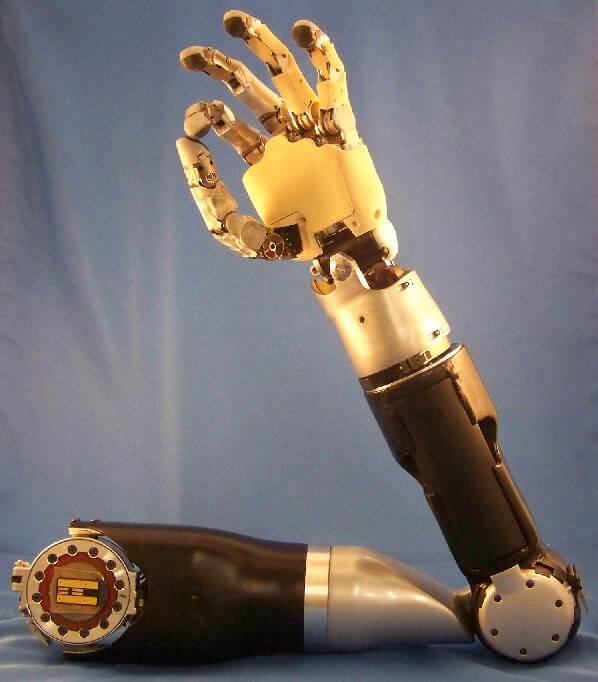
The world’s first human testing of a mind-controlled artificial limb is ready to begin. A joint project between the Pentagon and Johns Hopkins Applied Physics Laboratory (APL), the Modular Prosthetic Limb will be fully controlled by sensors implanted in the brain, and will even restore the sense of touch by sending electrical impulses from the limb back to the sensory cortex. Last month APL announced it was awarded a $34.5 million contract with DARPA, which will allow researchers to test the neural prosthesis in five individuals over the next two years.
We’ve been reporting on major advances in artificial limbs for a while now, but this is the holy grail of prosthetic technology. Phase III testing – human subjects testing – will be used to tweak the system, both improving neural control over the limb and optimizing the algorithms which generate sensory feedback. The Modular Prosthetic Limb (MPL) is the product of years of prototype design – it includes 22 degrees of motion, allows independent control of all five fingers, and weighs the same as a natural human arm (about nine pounds). Patients will control the MPL with a surgically implanted microarray which records action potentials directly from the motor cortex.
Researchers plan to install the first system into a quadriplegic patient; while amputees can be outfitted with traditional prostheses, the MPL will be the first artificial limb that can sidestep spinal cord injury by plugging directly into the brain. This isn’t the first brain-controlled interface to be used in humans – we’ve previously reported on Braingate, a system that uses brain impulses to control computer cursors and restore communication to locked-in patients. But the MPL will offer the first hard-wired neural control of bionic body parts, whether lost to injury or neurodegenerative disease.
The Defense Advanced Research Projects Agency (DARPA) is the one of more conceptually adventurous R&D agencies run through the Department of Defense. The brain-interface MPL is the most cutting-edge project – in fact, the original purpose – of their larger Revolutionizing Prosthetics program, which aims to improve prosthetic technology to treat veterans who have lost limbs in combat. DARPA often collaborates with (i.e. funds) university research teams and companies whose expertise can speed research along.
Such was the case with the Deka Luke Arm, a competing prosthesis technology which we covered last year. Deka, which is owned and run by Segway inventor Dean Kamen, was awarded $18 million by DARPA as part of the Revolutionizing Prosthetics program. The result is the Luke Arm, a prosthesis with 18 degrees of freedom that can be controlled in several ways. Generally, the prosthesis is hooked up to both pads under the feet (kind of like a remote joystick) as well as shoulder sensors. The Luke Arm has also been wired into patients’ remaining chest nerves, using a technique called targeted muscle reinnervation. This technique allows something comparable to the MPL (users’ thoughts control their own nerves, wired to the prosthesis). The Smart Hand (which we covered last year) was developed by EU researchers and uses a similar prosthesis-to-nerve connection.
The Luke Arm is an impressive leap forward for prosthetic technology, offering precise movement as well as pressure control – plus it’s already in clinical trials. But if the MPL can deliver on its promise of a cleanly-controlled prosthesis that is wired directly to the brain, it will most likely become the gold standard of artificial limbs. What remains to be seen is how well the brain sensors can translate a patient’s intentions into smooth, functional movements of the arm (and whether they can do better than muscle reinnervation). The agency is working to improve the precision of neural recordings, as well as boost the maximum number of impulses that can be recorded per second. Improving these spatial and temporal recordings will help to match the MPL’s movements to the patient’s intentions.
The biggest problem with neural interfaces is their short lifespan. Over time, silicon chips embedded in wet tissue begin to break down within the body, and need to be replaced within about two years. Earlier this year, DARPA announced a program called Histology for Interface Stability Over Time; the goal is to pinpoint how and why neural implants fail, and ultimately to boost their lifespan to 70 years. Without more permanent neural arrays, patients would need to undergo replacement surgery multiple times over their lifespan.
While the research is primarily a joint venture between Johns Hopkins and DARPA, the project will tap multiple institutions for varying forms of expertise. The University of Pittsburgh (who have already implanted monkeys with sensors to control robot arms) and CalTech will help with brain-computer interface design. The University of Chicago will aid the project with restoring sensory input, which will be an integral part of the MPL. The University of Utah will provide experience with the actual brain sensors to be implanted, and HDT Engineered Technologies will bring their skill in prosthetic technology to the project.
The program has some serious hurdles to overcome, and undoubtedly more technical obstacles will present themselves as trials begin. That being said, this is the most exciting project in prosthetic science to date. A fully integrated artificial limb would mark a new milestone in bionic technology: wiring external devices safely and directly into the nervous system. No more remotely controlled sensors, no more muscular myosensors… instead, a direct line from thought to action, and sensory experience restored to the brain.
We’ll be keeping a close eye on the MPL as new information emerges on Phase III trials. And until we can show you its neural integration, check out the MPL working remotely:
[image credit: Johns Hopkins Applied Physics Laboratory; DARPA]


